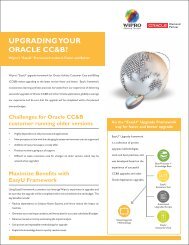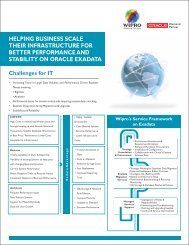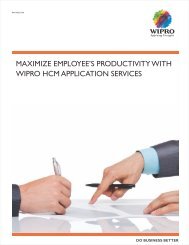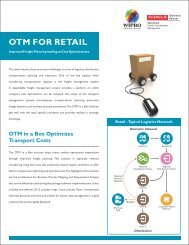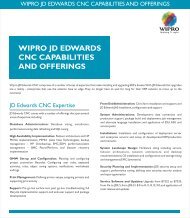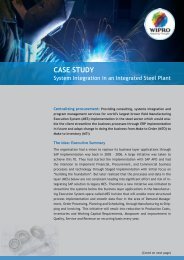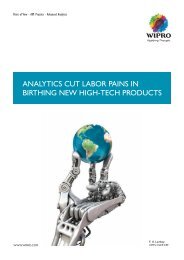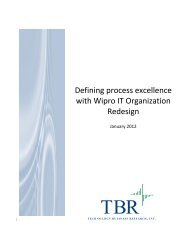The CIO Series
The CIO Series
The CIO Series
You also want an ePaper? Increase the reach of your titles
YUMPU automatically turns print PDFs into web optimized ePapers that Google loves.
WIPRO | Knowledge@Wharton<br />
AN IT EXPERT AND A STRATEGIC PARTNER<br />
His job calls for bringing two sets of skills to<br />
the table. He must understand what goals State<br />
Street wants to achieve, and what IT assets must<br />
be deployed to reach those results. Such an<br />
understanding helps to flesh out “a long-term<br />
plan for technology which fits with the overall<br />
context of the business strategy,” he says.<br />
Perretta is thus expected to be both an IT<br />
expert and a strategic partner who understands<br />
finance, marketing, branding and other<br />
business initiatives. “You just have to come<br />
to the realization that you’re paid to worry<br />
about technology and that’s a given,” he<br />
says. “Everybody just assumes that you have<br />
competency in that area and that you’ll make<br />
the right directions and put them in the business<br />
context.”<br />
Perretta begins by identifying IT architecture that<br />
can solve an operational challenge or capitalize<br />
on an opportunity. “We put that architectural<br />
initiative in the context of a business result,”<br />
he says. Getting the initiative right “has an<br />
immediate impact in the cost of operation and<br />
the level of service [State Street] can provide to<br />
customers.”<br />
Take a current IT project that aims to provide<br />
a single view of the life cycle of a trade as it<br />
progresses through the State Street organization.<br />
IT advances have made such a view possible and<br />
Perretta was able “to demonstrate and to quantify<br />
what that really means to the business” in terms<br />
of short- and long-term benefits. “It’s a heck of a<br />
lot easier to sell that into the business when they<br />
know they can [gain] the benefits associated with<br />
it,” he says.<br />
It’s also crucial to sell his IT team on the benefits<br />
of implementing a project. “You have to convince<br />
them that in doing so they’ll be able to deliver<br />
more for [State Street] customers, Perretta says.<br />
EVOLVING BEYOND<br />
C IO<br />
INFORMATION TECHNOLOGY<br />
That’s a key point for Perretta, who attempts to<br />
look at projects from the customer’s point of view.<br />
For example, “We are a trust bank,” he notes.<br />
“Our job is custody. It’s to safeguard things.<br />
So first and foremost you have to make sure<br />
you have the compliance, the controls and the<br />
security,” he says. This is a particularly sensitive<br />
requirement in today’s risk-averse financial<br />
services business, he adds.<br />
<strong>The</strong> macro economic environment increases<br />
the challenge of getting funding for IT projects.<br />
“To be blunt about it, in the go-go years, it was<br />
easier,” he recalls. Back then, businesses were<br />
focused more on top-line revenues, he explains.<br />
“In this environment it’s much more challenging.<br />
You have to look at both sides of the equation,<br />
the revenue and the cost sides, more like a<br />
manufacturing company.”<br />
LEAN INVESTMENTS IN A TOUGH BUSINESS<br />
CLIMATE<br />
Such cost-watching increases the importance<br />
of keeping IT operations lean. In a time of flat<br />
budgets, new product development can get<br />
squeezed as the consumption of IT hardware,<br />
software, storage and related services increases,<br />
Perretta says. “You have to make the case<br />
for fundamentally changing the IT model or<br />
else you’re going to run out of juice on the<br />
development side,” he adds. “And that’s a real<br />
challenge because no one’s had to manage<br />
through environments like this before.”<br />
State Street’s board and senior management<br />
are “very supportive” of IT, Perretta says.<br />
<strong>The</strong>y appreciate that one has to make certain<br />
minimum investments to achieve the next<br />
level of performance, he says. “Frankly, the<br />
use of technology is going up faster than<br />
revenue and faster than any kind of productivity<br />
improvement,” he adds.<br />
Chris Perretta | 3




